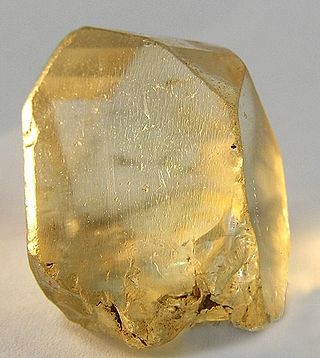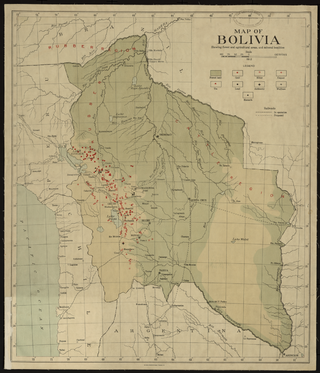
Mining is the extraction of valuable geological materials and minerals from the Earth and other astronomical objects. Mining is required to obtain most materials that cannot be grown through agricultural processes, or feasibly created artificially in a laboratory or factory. Ores recovered by mining include metals, coal, oil shale, gemstones, limestone, chalk, dimension stone, rock salt, potash, gravel, and clay. The ore must be a rock or mineral that contains valuable constituent, can be extracted or mined and sold for profit. Mining in a wider sense includes extraction of any non-renewable resource such as petroleum, natural gas, or even water.

Coltan is a dull black metallic ore from which the elements niobium and tantalum are extracted. The niobium-dominant mineral in coltan is columbite, and the tantalum-dominant mineral is tantalite.

The Bingham Canyon Mine, more commonly known as Kennecott Copper Mine among locals, is an open-pit mining operation extracting a large porphyry copper deposit southwest of Salt Lake City, Utah, in the Oquirrh Mountains. The mine is the largest man-made excavation, and deepest open-pit mine in the world, which is considered to have produced more copper than any other mine in history – more than 19,000,000 short tons. The mine is owned by Rio Tinto Group, a British-Australian multinational corporation. The copper operations at Bingham Canyon Mine are managed through Kennecott Utah Copper Corporation which operates the mine, a concentrator plant, a smelter, and a refinery. The mine has been in production since 1906, and has resulted in the creation of a pit over 0.75 miles (1,210 m) deep, 2.5 miles (4 km) wide, and covering 1,900 acres. It was designated a National Historic Landmark in 1966 under the name Bingham Canyon Open Pit Copper Mine. The mine experienced a massive landslide in April 2013 and a smaller slide in September 2013.
Mount Isa Mines Limited ("MIM") operates the Mount Isa copper, lead, zinc and silver mines near Mount Isa, Queensland, Australia as part of the Glencore group of companies. For a brief period in 1980, MIM was Australia's largest company. It has pioneered several significant mining industry innovations, including the Isa Process copper refining technology, the Isasmelt smelting technology, and the IsaMill fine grinding technology, and it also commercialized the Jameson Cell column flotation technology.

The mining industry of the Democratic Republic of the Congo produces copper, diamonds, tantalum, tin, gold, and more than 63% of global cobalt production. Minerals and petroleum are central to the DRC's economy, making up more than 95% of the value of its exports.
The Red Dog mine is a large zinc and lead mine in a remote region of Alaska, about 80 miles (130 km) north of Kotzebue, which is owned and operated by the Canadian mining company Teck Resources. It is located within the boundaries of the Red Dog Mine census-designated place in the Northwest Arctic Borough of the U.S. state of Alaska.

Mining is important to the economy of Ethiopia as a diversification from agriculture. Currently, mining comprises only 1% of GDP. Gold, gemstones, and industrial minerals are important commodities for the country's export-oriented growth strategy.

The mining of minerals in Nigeria accounts for only 0.3% of its gross domestic product, due to the influence of its vast oil resources. The domestic mining industry is underdeveloped, leading to Nigeria having to import minerals that it could produce domestically, such as salt or iron ore. The rights to ownership of mineral resources is held by the Federal Government of Nigeria, which grants titles to organizations to explore, mine, and sell mineral resources. Organized mining began in 1903, when the Mineral Survey of the Northern Protectorates was created by the British colonial government. A year later, the Mineral Survey of the Southern Protectorates was founded. By the 1940s, Nigeria was a major producer of tin, columbite, and coal. The discovery of oil in 1956 hurt the mineral extraction industries, as government and industry both began to focus on this new resource. The Nigerian Civil War in the late 1960s led many expatriate mining experts to leave the country. Mining regulation is handled by the Ministry of Solid Minerals Development, who are tasked with the responsibility of overseeing the management of all mineral resources in Nigeria. Mining law is codified in the Federal Minerals and Mining Act of 1999. Historically, Nigeria's mining industry was monopolized by state-owned public corporations. This led to a decline in productivity in almost all mineral industries. The Obasanjo administration began a process of selling off government-owned corporations to private investors in 1999. The Nigerian Mining Industry has picked up since the "Economic Diversification Agenda", from Oil & Gas, to Agriculture, Mining, etc., began in the country.

Mining is the biggest contributor to Namibia's economy in terms of revenue. It accounts for 25% of the country's income. Its contribution to the gross domestic product is also very important and makes it one of the largest economic sectors of the country. Namibia produces diamonds, uranium, copper, magnesium, zinc, silver, gold, lead, semi-precious stones and industrial minerals. The majority of revenue comes from diamond mining. In 2014, Namibia was the fourth-largest exporter of non-fuel minerals in Africa.

Mining in Bolivia has been a dominant feature of the Bolivian economy as well as Bolivian politics since 1557. Colonial era silver mining in Bolivia, particularly in Potosí, played a critical role in the Spanish Empire and the global economy. Tin mining supplanted silver by the twentieth century and the central element of Bolivian mining, and wealthy tin barons played an important role in national politics until they were marginalized by the industry's nationalization into the Bolivian Mining Corporation that followed the 1952 revolution. Bolivian miners played a critical part to the country's organized labor movement from the 1940s to the 1980s.

Tanco Mine or Bernic Lake mine is an underground caesium and tantalum mine, owned and since 2019 owned and operated by Sinomine Resource Group on the north west shore of Bernic Lake, Manitoba, Canada. The mine has the largest known deposit of pollucite and is also the world's largest producer of caesium.

The Toquepala mine is a large porphyry copper mine in the Tacna Province, Tacna Department, Peru. The mine is an open-pit mine producing copper, molybdenum, rhenium and silver with minor gold and zinc.
Mining in North Korea is important to the country's economy. North Korea is naturally abundant in metals such as magnesite, zinc, tungsten, and iron; with magnesite resources of 6 billion tonnes, particularly in the North and South Hamgyong Province and Chagang Province. However, often these cannot be mined due to the acute shortage of electricity in the country, as well as the lack of proper tools to mine these materials and an antiquated industrial base. Coal, iron ore, limestone, and magnesite deposits are larger than other mineral commodities. Mining joint ventures with other countries include China, Canada, Egypt, and South Korea.

The Greenbushes lithium mine is an open-pit mining operation which is in Western Australia and is the world's largest hard-rock lithium mine. It is located to the south of the town of Greenbushes, Western Australia. The Greenbushes lithium mine produces approximately 1.95 million tonnes of lithium spodumene annually. The mine is 250 kilometres (160 mi) south of Perth and 90 kilometres (56 mi) southeast of the Port of Bunbury.
The Manono-Kitolo mine is a former tin and coltan mine, which also contains one of the largest lithium reserves globally, in the Democratic Republic of the Congo. The mine is located in southern Democratic Republic of the Congo in Tanganyika Province. The Manono-Kitolo mine has reserves amounting to 120 million tonnes of lithium ore grading 0.6% lithium thus resulting 0.72 million tonnes of lithium.

Australia has one of the biggest lithium reserves and is the biggest producer of lithium by weight, with most of its production coming from mines in Western Australia. Most Australian lithium is produced from hard-rock spodumene, in contrast to other major producers like Argentina, Chile and China, which produce it mainly from salt lakes.

The Harding Pegmatite Mine is a former adit mine that extracted lithium, tantalum, and beryllium from a Precambrian pegmatite sill. It ceased operations in 1958 and its owner, Arthur Montgomery, donated it to the University of New Mexico, which runs the site as an outdoor geology laboratory with mineral collecting permitted on a small scale.

The Lega Dembi Mine is the largest gold mine in Ethiopia and is near Shakiso in Oromia. Lega Dembi has a yearly production of around 4,500 kg of gold and silver, and is owned by MIDROC. Pollution from the mine has resulted in environmental conflict that has exacerbated other political and ethnic conflict in the region.
The Ministry of Mines and Petroleum is a government ministry responsible for management of mining and petroleum sector in Ethiopia. It was established in 2018 under Proclamation No 1097/2018 and Melese Alemu served as the first Minister of the position. In 2020, Takele Uma Banti succeeded as the Minister of Mines and Petroleum until 14 January 2023.
The Finnis Lithium Project is a lithium mine being developed near Darwin, Northern Territory, Australia. The project is being developed by Core Lithium.













